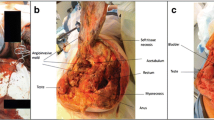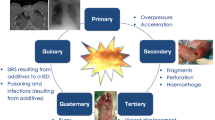Abstract
Introduction
In suicide bomber attacks (SBAs), the explosive forces may disperse fragments from the body of the bomber to which the device is attached. This biologic material can cause physical injury to bystanders and may represent a source of severe infectious diseases.
Patients and methods
Two French soldiers, victims of an SBA in Africa, were managed in the Percy Military Teaching Hospital. They sustained multiple injuries, including some caused by bony fragments converted into projectiles by the explosion. One patient had multiple superficial wounds managed conservatively. The other was treated surgically by serial debridement with removal of a bony piece related to the suicide bomber. The decision not to prescribe antiretroviral therapy was determined after discussion with infectious disease specialists.
Results
Blood tests for HIV, HCV and HBV were taken at months zero, three and six; all were negative.
Conclusion
In the French Military Health Service, guidelines are based on evaluation of the viral status of the bomber and on the regional HIV prevalence breakpoint. There is no indication for HCV post-exposition prophylaxis (PEP). Accessible human foreign bodies related to an SBA should be removed as soon as possible, in association with antibiotic medication and a possible HIV PEP. These infectious risks have been discussed in some military and law enforcement literature. It should be a risk-based decision supported by medical intelligence.
Similar content being viewed by others
References
Eshkol Z, Katz K (2005) Injuries from biologic material of suicide bombers. Injury 36:271–274. doi:10.1016/j.injury.2004.06.016
Chapman LE, Sullivent EE, Grohskopf LA et al (2008) Recommendations for postexposure interventions to prevent infection with hepatitis B virus, hepatitis C virus, or human immunodeficiency virus, and tetanus in persons wounded during bombings and other mass-casualty events—United States, 2008: recommendat. MMWR Recomm Rep 57:1–21, quiz CE1–4
Alvarado-Ramy F, Beltrami EM (2003) New guidelines for occupational exposure to blood-borne viruses. Cleve Clin J Med 70:457–465
Agency EGC by the HP (2005) Post exposure prophylaxis against hepatitis B for bomb victims and immediate care providers. Consideration of other blood borne viruses (hepatitis C and HIV)
Kosashvili Y, Loebenberg MI, Lin G et al (2009) Medical consequences of suicide bombing mass casualty incidents: the impact of explosion setting on injury patterns. Injury 40:698–702. doi:10.1016/j.injury.2008.06.037
Braverman I, Wexler D, Oren M (2002) A novel mode of infection with hepatitis B: penetrating bone fragments due to the explosion of a suicide bomber. Isr Med Assoc J 4:528–529
Eylon S, Mosheiff R, Liebergall M et al (2005) Delayed reaction to shrapnel retained in soft tissue. Injury 36:275–281. doi:10.1016/j.injury.2004.09.005
Patel HDL, Dryden S, Gupta A, Stewart N (2012) Human body projectiles implantation in victims of suicide bombings and implications for health and emergency care providers: The 7/7 experience. Ann R Coll Surg Engl 94:313–317. doi:10.1308/003588412X13171221591772
Wong JM-L, Marsh D, Abu-Sitta G et al (2006) Biological foreign body implantation in victims of the London July 7th suicide bombings. J Trauma 60:402–404. doi:10.1097/01.ta.0000203715.31280.65
Clint BD (2009) Force protection and infectious risk mitigation from suicide bombers. Mil Med 174:709–714
Frickmann H, Wulff B, Loderstædt U et al (2013) From IEDs to AIDS? Detection of HIV in human corpses by rapid screening tests after suspected intentional transmission in terrorist attacks. J R Army Med Corps 159:278–282. doi:10.1136/jramc-2013-000048
Mathieu L, Ouattara N, Poichotte A et al (2014) Temporary and definitive external fixation of war injuries: use of a French dedicated fixator. Int Orthop 38:1569–1576. doi:10.1007/s00264-014-2305-2
Dienstknecht T, Horst K, Sellei RM et al (2012) Indications for bullet removal: overview of the literature, and clinical practice guidelines for European trauma surgeons. Eur J Trauma Emerg Surg 38:89–93. doi:10.1007/s00068-011-0170-x
P. Morlat G d’Expert Rapport 2013 sur la prise en charge médicale des personnes vivant avec le VIH. CNS, ANRS
World Health Organization (2007) Post-exposure prophylaxis to prevent HIV infection: joint WHO/ILO guidelines on post-exposure prophylaxis (PEP) to prevent HIV infection. World Health 1–104
Author information
Authors and Affiliations
Corresponding author
Ethics declarations
Conflict of interest
The authors declare that they have no conflict of interest.
The information and views set out in this article are those of the author(s) and do not necessarily reflect the official opinion of the French Military Health Service.
Rights and permissions
About this article
Cite this article
de l’Escalopier, N., Mathieu, L., Valade, G. et al. Infectious risk for suicide bomber attack victims: management of penetrative wounds in French Army personnel. International Orthopaedics (SICOT) 40, 861–864 (2016). https://doi.org/10.1007/s00264-016-3114-6
Received:
Accepted:
Published:
Issue Date:
DOI: https://doi.org/10.1007/s00264-016-3114-6




